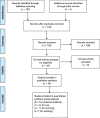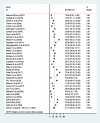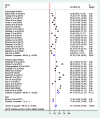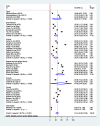Male and undernourished children were at high risk of anemia in Ethiopia: a systematic review and meta-analysis
- PMID: 29996879
- PMCID: PMC6042228
- DOI: 10.1186/s13052-018-0513-x
Male and undernourished children were at high risk of anemia in Ethiopia: a systematic review and meta-analysis
Abstract
Background: Anemia is one of the global public health problems affecting more than one-third of the world population. It has been strongly associated with limited psychomotor development; and poor growth and performance in cognitive, social, and emotional function in children. Despite published data revealed that anemia is a public health problem among children in Ethiopia, there is no a pooled national estimate on the prevalence and associated risk factors of anemia.
Methods: Published articles until December 31, 2017, were searched using comprehensive search strings through PubMed/Medline, EMBASE, SCOPUS, HINARI, Web of Science, Google Scholar and Google. Reference probing of published articles and hand searching were employed for grey literature. Two groups of review authors independently appraised the studies for eligibility and extracted the data. The quality of articles was assessed using Joana Brigg's institute critical appraisal checklist for prevalence and analytical studies. The pooled estimates were determined using random effect model. Heterogeneity between the included studies was assessed using the I2 statistics. Subgroup analysis was employed in the evidence of heterogeneity. Publication bias was assessed by visual inspection of the funnel plot and Egger's regression test statistic.
Results: Of the total 871 articles retrieved, 34 articles which involved 61,748 children were eligible for meta-analysis. The overall pooled prevalence of anemia using random effect model was 31.14% (95% CI: 24.62, 37.66%). In subgroup analysis, the pooled prevalence of anemia was higher among preschool-aged children (44.17%; 95% CI: 37.19, 51.15%) than school-aged children (22.19%; 95% CI: 17.54, 26.83%). Furthermore, the odds of anemia was higher among children who were male (OR = 1.11; 95% CI: 1.03, 1.19), stunted (OR = 1.95; 95% CI: 1.52, 2.51), and wasted (OR = 2.05; 95% CI: 1.36, 3.10).
Conclusion: The pooled prevalence of anemia among children was high, indicating that it had been continuing to be a public health problem. Therefore, there is a need to design a comprehensive prevention and control strategies to reduce its burden.
Keywords: Anemia; Children; Ethiopia; Meta-analysis.
Conflict of interest statement
Ethics approval and consent to participate
Not applicable.
Consent for publication
Not applicable.
Competing interest
The authors declare that they have no competing interest.
Publisher’s Note
Springer Nature remains neutral with regard to jurisdictional claims in published maps and institutional affiliations.
Figures







Similar articles
-
Prevalence of anemia and its associated factors among children in Ethiopia: a protocol for systematic review and meta-analysis.EJIFCC. 2018 Jul 11;29(2):138-145. eCollection 2018 Jul. EJIFCC. 2018. PMID: 30050397 Free PMC article.
-
Prevalence of anemia and its associated factors among children aged 6-23 months, in Ethiopia: a systematic review and meta analysis.BMC Public Health. 2023 Dec 2;23(1):2398. doi: 10.1186/s12889-023-17330-y. BMC Public Health. 2023. PMID: 38042804 Free PMC article.
-
Sero-epidemiology and associated factors of HIV, HBV, HCV and syphilis among blood donors in Ethiopia: a systematic review and meta-analysis.BMC Infect Dis. 2021 Aug 9;21(1):778. doi: 10.1186/s12879-021-06505-w. BMC Infect Dis. 2021. PMID: 34372772 Free PMC article.
-
Predictors of anemia among HIV-infected children in Ethiopia: systematic review and meta-analysis.Sci Rep. 2025 Feb 18;15(1):5968. doi: 10.1038/s41598-025-85285-8. Sci Rep. 2025. PMID: 39966543 Free PMC article.
-
Burden and determinants of scabies in Ethiopian school age children: A systematic review and meta-analysis with public health implications.PLoS One. 2024 Dec 19;19(12):e0314882. doi: 10.1371/journal.pone.0314882. eCollection 2024. PLoS One. 2024. PMID: 39700220 Free PMC article.
Cited by
-
A systematic review and meta-analysis of the prevalence and predictors of anemia among children in Ethiopia.Afr Health Sci. 2020 Dec;20(4):2007-2021. doi: 10.4314/ahs.v20i4.59. Afr Health Sci. 2020. PMID: 34394267 Free PMC article.
-
Heart Failure in Ethiopian Children: Mirroring the Unmet Cardiac Services.Ethiop J Health Sci. 2019 Jan;29(1):811-818. doi: 10.4314/ejhs.v29i1.2. Ethiop J Health Sci. 2019. PMID: 30700948 Free PMC article.
-
Prevalence and associated risk factors of asymptomatic malaria and anaemia among school-aged children in Dara Mallo and Uba Debretsehay districts: results from baseline cluster randomized trial.Malar J. 2021 Oct 13;20(1):400. doi: 10.1186/s12936-021-03937-2. Malar J. 2021. PMID: 34645464 Free PMC article.
-
Prevalence and Determinants of Undernutrition in Schoolchildren in the Kilombero District, South-Eastern Tanzania.Trop Med Infect Dis. 2024 Apr 25;9(5):96. doi: 10.3390/tropicalmed9050096. Trop Med Infect Dis. 2024. PMID: 38787029 Free PMC article.
-
Factors associated with childhood anaemia in Afro-descendant communities in Alagoas, Brazil.Public Health Nutr. 2021 Oct;24(15):4888-4898. doi: 10.1017/S1368980020004711. Epub 2020 Nov 19. Public Health Nutr. 2021. PMID: 33210585 Free PMC article.
References
-
- WHO . The global prevalence of anaemia in 2011. Geneva: World Health Organization; 2015.
-
- Harika R, Faber M, Samuel F, Mulugeta A, Kimiywe J, Eilander A. Are low intakes and deficiencies in Iron, vitamin a, zinc, and iodine of public health concern in Ethiopian, Kenyan, Nigerian, and south African children and adolescents. Food Nutr Bull. 2017; - PubMed
-
- Walter T. Effect of iron-deficiency anemia on cognitive skills and neuromaturation in infancy and childhood. Food Nutr Bull. 2003;24(4) - PubMed
Publication types
MeSH terms
LinkOut - more resources
Full Text Sources
Other Literature Sources
Medical

